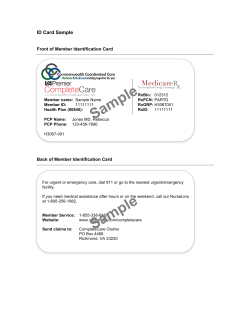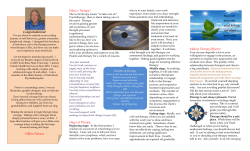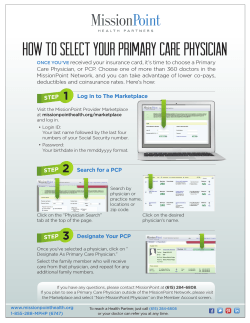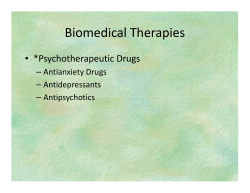
Document 242994
Workshop Outline Promoting change in primary Care Our goal is to teach (and other brief settings) Patricia J Robinson, PhD Debra A. Gould, MD, MPH robinsonpatricia@me.com deb.gould@commhealthcw.org ACBS Washington DC July 2012 Principles for successful implementation of the Psychological Flexibility model Case conceptualization and intervention methods Ways to promote resiliency in providers who work in brief treatment settings Tools for Patients: TEAMS, Hexaflex of Resilency, CPAT, Quick Guide, Bulls Eye Plan Tools for Providers: Personal / Professional Bulls Eye, Burnout Prevention Plan 1 2 WHy Be Brief? Patient Access is Needed by Many and Difficult for Most What Do Patients Want? Patient Preference Reduce stigma I want to be seen when I want help, not later From before birth to preparation for death) I don t want to be seen as crazy or needing pills or having to go for a lot of appointments Brief approaches emphasize patient s strengths; normalize suffering Access is haphazard at best Pills in PC, Jails, ERs, Hospitals 3 4 Why PC? Resources are limited and . . . Patients want primary care . . . increase in use of PC as the chief source of MH tx across the US has occurred across all levels of psychiatric severity, not just milder forms . . . use of PC has outpaced increases in specialty MH care access (Wang et al., 2006) . . . and, by the way, research suggests equivalent levels of psychopathology and likelihood of psychiatric diagnosis across both specialty mental health and PC settings (Tata, Eagle, & Green, 1996) 5 Access to MH services is very limited, particularly for underserved and in rural areas and particularly for economically challenged people Greatest amount of improvement occurs very early in treatment with diminishing returns of benefit over time. (Kopta ea al.; Ilardi & Craighead, 1994) Lengthier, time-unlimited therapies do not always demonstrate incremental efficacy compared to brief therapies (Knekt et al., 2008; see also Steenbarger, 1994 for a review) 6 1 Bottom Line: The Primary Care Behavioral Health (PCBH) Model * PC is the De-Facto MH System PCP is first medical professional with whom a patient discusses MH or behavioral difficulties 70-85% of PC visits are attributable to psychosocial or behavioral causes (Gatchel & Oordt, 2003; Kroenke & Mangelsdorf, 1989) So, the push is on to integrate BH services into PC The barriers: A model for providing BH services Translation of the most potent and user-friendly psychotherapy interventions to the demands of brief tx Embeds MH professionals within PC clinics to serve as BHCs to the PC team Goal is to improve detection, diagnosis and treatment of psychosocial health issuess Brief appointments (typically 15 to 30 minutes in length), time-limited contact with patients (frequently only 1-2 appoints) and collaborative decision-making with PCPs PCPs refer patients to BHCs, who conduct assessments and provide interventions in support of the PCP s tx plan, then provide recommendations and feedback to the PCP to further augment overall tx plan PCP retains full responsibility for patient care decisions *Robinson & Reiter, 2007; Strosahl, 1996, 1997, 1998 7 8 Clinical Features of BHC work Clinical Features of BHC work Focus on rapid problem identification with active involvement of clinician and patient in stills training, with emphasis on self-management BHCs are directive (e.g., set an agenda, ask for specific examples of problems, educate patients, teaching and practice skills in-session, assign between appointment skill practice, monitor adherence and acquisition of skill mastery) Concrete clinical actions have been shown to significantly predict early clinic improvment (DeRubeis & Feeley, 1990) 9 Improved patient SXS and functioning (Asarnow et al., ppolonio, 2009; Cigrang, Dobmeyer, Beckness, RoaNavarrete, & Yerian, 2006; Corso et al., 2009; Davis, Corrin-Pendry, & Savill, 2008; Katon et al., 2002; RoyBryne, Katon, Cowley, & Russo, 2001; Simon et al., 2001; Unutzer et al., 2002) More specifics Improved Patient Retention (Katon, et al., 1996) BHC uses empirically supported treatments that have been shown to contribute to improved clinical outcomes in fewer tx sessions across a diverse outpatient population without exclusion (Cukrowicz et al., 2005) 10 What are the Benefits of PCBH Care? BHC s routine practice of assigning behavioral prescriptions (called homework in psychotherapy) for skill practice and monitoring at followup is also associated with improved outcomes (Detweiler & Whisman, 1999) Reduced HC costs (Katon, Roy-Byrne, Russo, & Cowley, 2002) Reduction of PCP workload (Davis et al., 2008; Spitzer et al., 1994) Patients improve across tx sessions (Bryan et al., 2009; Brian et al., 2010; Cigrang et al., 2006) Patterns of improvement mirror the earliest stages of traditional outpatient psychotherapy (e.g., Howard, Kopta, Krause, & Orlinsky, 1986; Kadera, Lambery, & Andrews, 1996) Recovery typically occurs within 4 PCBH appointments (Bryan et al., 2010) Strengthened doctorpatient relationships (Simon, 1992) 11 12 2 But does It work for People with severe problems? and do People sustain their gains? More severe improve Patient-focused method of outcomes research suggests a dosage model of psychotherapy (Kopta, Howard, Lowry, & Buetler, 194) rather than the traditional efficacy and effectiveness outcomes methodology to answer questions about which patients will respond to which treatments (Kopta et al., 1994) Bryan, Corso, Kanzler, Corso, Morrow, & Ray-Sannerud (2012) took this approach, studying 495 PC patients and creating 3 models to identify clinical improvement in terms of # appts attended, baseline impairment severity level, and interaction of these 2. The results: 13 664 patients who received BHC care in large family medicine clinic, completed BHM (20-item self-report) at all visits and by mail 1.5 to 3 years after end of care; 70 returned (63% female, mean age 43, 47% Caucsian, 13% African American, 21% Hispanic / Latino, 3% Asian / Pac Islander, 10% other); Mixed effects modeling Results: Patients improved from 1st to last BHC appointment Gains maintained on average of 2 years after care Patterns of results remained significant even when accounting for the receipt of additional MH tx subsequent to BHC care 14 Better diabetes management and significant improvement in Hemoglobin A1C measurement (Gregg, et al, 2007) Improved rates of smoking cessation (Gifford, et al., 2004) Powerful treatment for chronic pain and disability behavior (McCracken et al., 2004) 495 PC patients (and other Brief TX settings) Patients with more severe impairment at BQ improved faster than patients with less severe BQ impairment ACT Fits PC Is the dose sufficient for sustained improvements over time?* 71.5% improved across appts Reduced rates of seizures and improved QOL in patients with uncontrolled seizure disorder (Lundgren, et al., 2008) Helpful to depressed patients (Zettle & Hayes, 1986) and polysubstance abusing methadone-maintained opiate addicts (Hayes, et al., 2004) Better than usual care or waiting lists and as effective as other CB or psychotherapies in tx of many traditional mental health problems commonly seen in primary care (Powers, et al, 2009), including anxiety (Hayes, et al, 2006) *Ray-Sannerud, Morrow, Kanzler, Dolan, Corso, & Corso, 2012 15 16 Tools for Promoting Change in Patients 17 18 3 TEAMS Exercise: Imagine going having a concern about your health, mental or physical or both, and deciding to ask someone for help Private Event Element Your observations Thoughts Emotions Associations Memories Sensations 19 20 Core Process Assessment Tool (CPAT) Real Behavior Change Quick Guide Inflexibility Points Rating (0-10) Flexibility Stuck TEAM/Rules Step Back In past or future Present Moment Stuck / self story Observer sees Values disconnect Values Connect Impulsive, passive, selfdefeating Sustain Valued Action Total Score 1 page pocket guide (put in on your wall, in your clip board or in your pocket) 3+ interventions for each of the 6 Processes / Points of Psychological Flexibility Categorized by Process / Point Bulls Eye involves multiple processes, as do several others (Range = 0-60) 21 22 Tools for Interviewing Briefly 23 Love, Work, Play & Health Three Ts (Time, Trigger, Trajectory) and WORKABILITY Brief Assessments (0-10, all visits): Problem severity, confidence and helpfulness 24 4 The Health context Experiential avoidance is a common response to lifestyle and health concerns The culture in the US doesn t promote a strong value connection with health PC Providers are challenged to the max! 25 26 27 28 Tools for Promoting Provider Resilience 29 30 5 31 32 33 34 And More Resources Out this month: Brief Interventions for Radical Change: Principles and Practice Of Focused Acceptance and Commitment TherapyStrosahl, Robinson &GustavssonNew Harbinger http://www.contextualpsychology.org/ http://www.newharbingeronline.com/ real-behavior-change-in-primary-care.html 35 36 6 Stay in touch . . . deb.gould@commhealthcw.org robinsonpatricia@me.com 37 7
© Copyright 2025





















